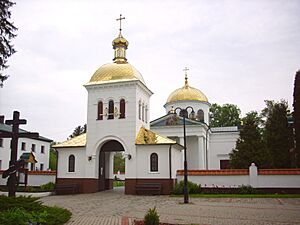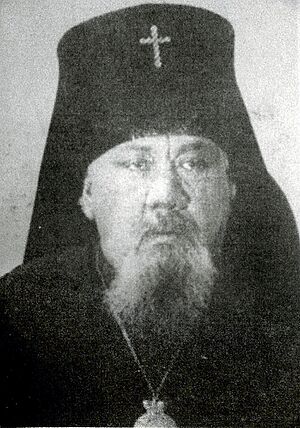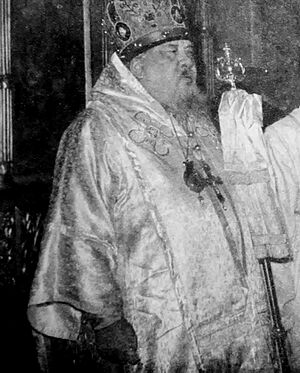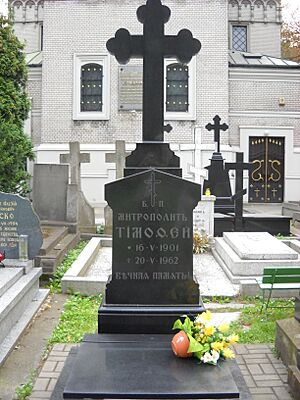Timothy Szretter facts for kids
Quick facts for kids Timothy |
|
|---|---|
| Metropolitan of Warsaw and all Poland | |
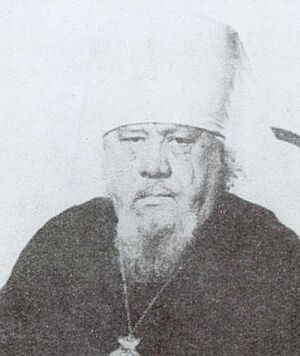 |
|
| Church | Polish Orthodox Church |
| In Office | 1961–1962 |
| Orders | |
| Ordination | 1938 |
| Consecration | 27 November 1938 by Dionysius Waledyński |
| Personal details | |
| Birth name | Jerzy Szretter |
| Born | May 16, 1901 Tomachów near Rivne |
| Died | May 20, 1962 (aged 61) Warsaw |
| Buried | Orthodox Cemetery, Warsaw |
| Denomination | Eastern Orthodoxy |
Timothy, whose birth name was Jerzy Szretter, was an important Polish Orthodox church leader. He was born on May 16, 1901, near Rivne and passed away on May 20, 1962, in Warsaw. He became the third Metropolitan of Warsaw and all Poland, which is the highest leader of the Polish Orthodox Church.
After finishing his studies and becoming a priest, he worked in the Volhynian area. He also served as a chaplain for Orthodox soldiers in the Polish army. In 1938, he became a bishop. During World War II, he stayed at the Monastery of St. Onuphrius in Jabłeczna. This was because he strongly supported making the Polish Orthodox Church more Polish, a view he held before the war.
Between 1948 and 1951, and again from 1959 to 1961, he temporarily led the Polish Orthodox Church when it didn't have a main leader. In 1961, he was chosen as the Metropolitan of Warsaw and all Poland. This election had support from the Polish government and didn't follow all the church's rules. This caused some protests from other church members. He died just one year after becoming the Metropolitan.
Contents
Early Life and Priesthood
Jerzy Szretter finished high school in Ostroh. From 1925 to 1930, he studied at the Orthodox Theological Seminary in Warsaw. On August 11, 1930, he became a priest at the Pochaiv Lavra. He was then assigned to serve in the parish of Łanowiec.
In 1933, he joined the reserve military clergy. This meant he could be called to serve as a chaplain for Orthodox soldiers. He was later called to active duty and worked as a dean in the Lublin military district. In 1938, after his wife Lidia passed away, he decided to take religious vows and dedicate his life fully to the church.
Becoming a Bishop
On November 27, 1938, Jerzy Szretter became a bishop at the Pochaiv Lavra. He was consecrated by Dionysius Waledyński, who was the Metropolitan of Warsaw and all Poland. Timothy was named the auxiliary bishop for the Warsaw-Chełm diocese, with the title of Bishop of Lublin.
Some historians believe his consecration was influenced by the Polish government. The government wanted to make the Polish Orthodox Church more Polish. Many church leaders at the time were Russians, Ukrainians, or Belarusians. However, Jerzy Szretter supported these plans to make the church more Polish. He worked towards this goal in the Warsaw-Chełm diocese after becoming a bishop. He was known as one of the strongest supporters of Polonization among the church's clergy.
During World War II
When World War II began, Bishop Timothy went to Warsaw from the St. Onuphrius Monastery in Jabłeczna. However, the new church leader in Warsaw, Metropolitan Serafin (Lade), sent him back to the monastery. This was because Bishop Timothy had strong pro-Polish views.
Bishop Timothy returned to church activities on September 30, 1940. He became a member of the council of bishops for the Orthodox Church in the General Government. He was given the title of auxiliary bishop for the Chełm-Podlachia diocese. However, he did not join the Church Synod because his pro-Polish views did not match the new policy of making the church more Ukrainian.
On August 10, 1944, the head of the Polish Committee of National Liberation, Edward Osóbka-Morawski, allowed Bishop Timothy to temporarily lead the Chełm-Podlachia diocese. During this time, many Ukrainians were moved to the USSR. This led to over 160 churches closing because there were no longer enough people to attend. Timothy did not object to this. He only asked that a few main parishes and the monastery in Jabłeczna remain under his care.
In October 1944, Bishop Timothy also took charge of Orthodox churches in the Białystok area. He opposed transferring these churches to the Russian Orthodox Church, even though some local priests wanted this.
After World War II
After the war, the government started suggesting that Metropolitan Dionysius, the head of the Polish Orthodox Church, should step down. Bishop Timothy was considered as a possible replacement. In 1945, he became a vice-president of the Polish Ecumenical Council, which works to bring different Christian churches together.
From 1946, as an archbishop, he led the Białystok-Bielsko diocese. This diocese was later renamed the Białystok-Gdańsk diocese in 1951. In 1947, he helped Orthodox Christians who had been moved to new parts of Poland. He organized church services and provided help for them. In the same year, he started the first women's monastery in post-war Poland, located on Grabarka Holy Mount.
In 1948, the government decided to remove Metropolitan Dionysius from his position. Until a new leader was chosen, the church was managed by a temporary group. Archbishop Timothy was the chairman of this group. In April 1948, he started talks with Patriarch Alexy I of Moscow to discuss the status of the Polish Orthodox Church. In June 1948, he was part of a group that went to Moscow. They agreed to receive the church's independence (called autocephaly) again from the Russian Orthodox Church.
The government asked Archbishop Timothy to have Metropolitan Dionysius move out of the metropolitan house in Warsaw. Archbishop Timothy, like other bishops, worked closely with the government. However, the plan for him to become the metropolitan was put on hold. The government felt he didn't have enough authority or organizational skills. Timothy remained the temporary leader until Archbishop Macarius Oksiyuk arrived from the USSR and became the head of the church in 1951. In 1950, Timothy helped open an Orthodox Theological School in Warsaw, which later became a seminary.
After 1956, Archbishop Timothy began to manage the church again. This was because Metropolitan Macarius was getting older and had poor health. The government saw Timothy as smart and understanding. They believed he would follow their orders, even if they were difficult.
Becoming Metropolitan of Warsaw
After Metropolitan Macarius passed away in 1961, the government helped Timothy become the new metropolitan. He had been the temporary leader since 1957. Church leaders from other countries, like the Ecumenical Patriarchate of Constantinople and the Romanian Orthodox Church, attended his special ceremony. The Patriarch of Moscow also approved his election.
However, Timothy was elected by a council of bishops, not by a larger electoral council as the church's rules stated. This led to protests from many priests and church members. They said his election was against church law. People sent complaints to various government offices and to the Patriarch of Moscow. One bishop, Bazyli Doroszkiewicz, also protested. He claimed that government officials had decided who would be metropolitan.
As Metropolitan of Warsaw and all Poland, Timothy represented the church in international meetings. He also participated in peace movements. In 1961, he started a Polish-speaking church in Warsaw. However, it closed because not enough people wanted services in Polish.
The disagreements about Metropolitan Timothy continued until he died on May 20, 1962. Metropolitan Timothy (Szretter) was buried in the Orthodox Cemetery in Warsaw.
Images for kids


